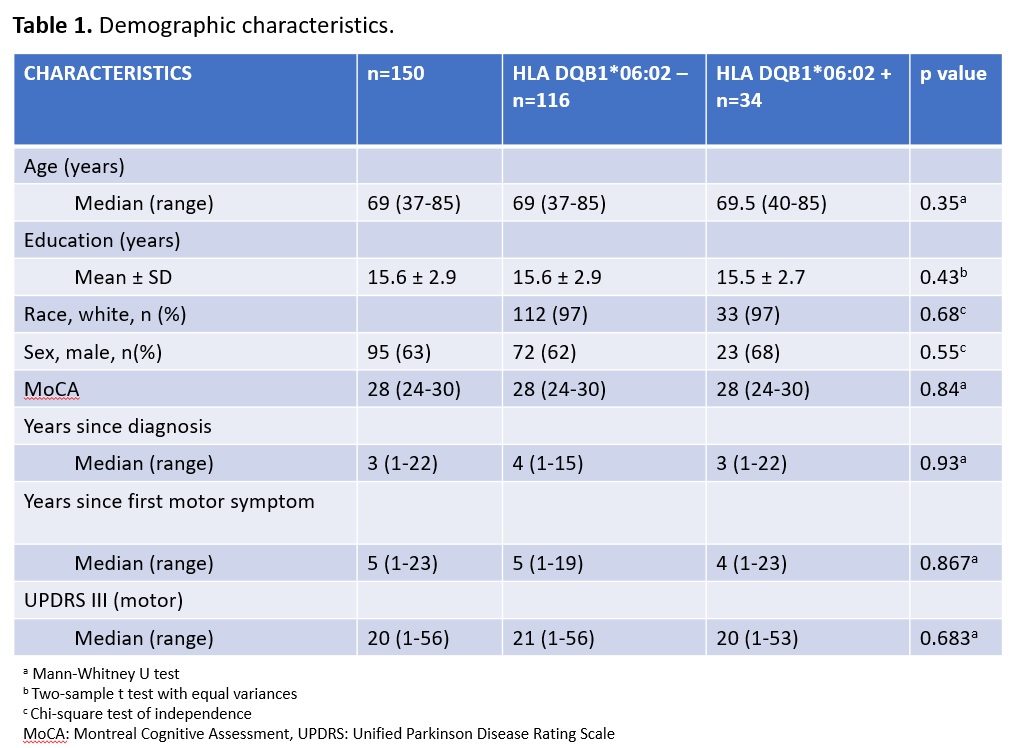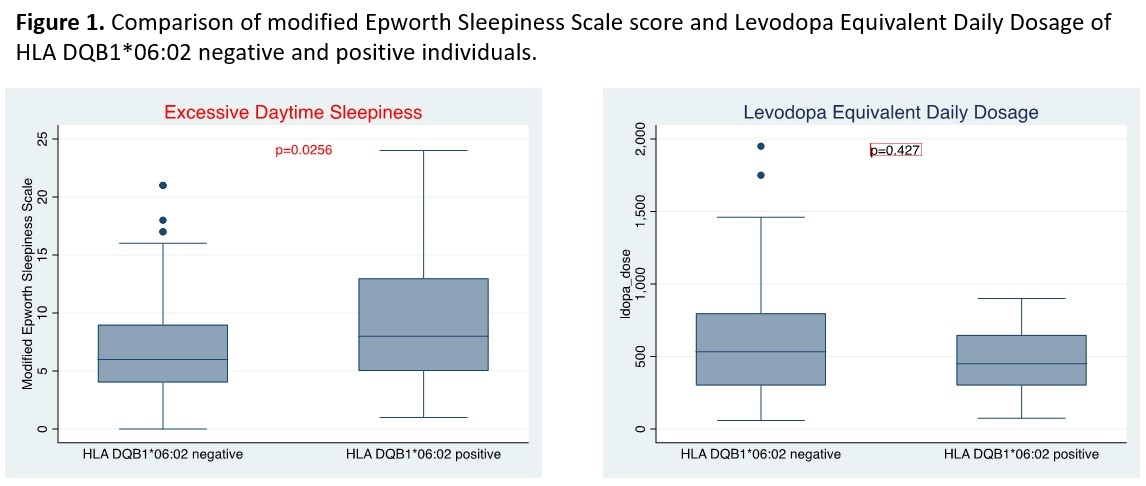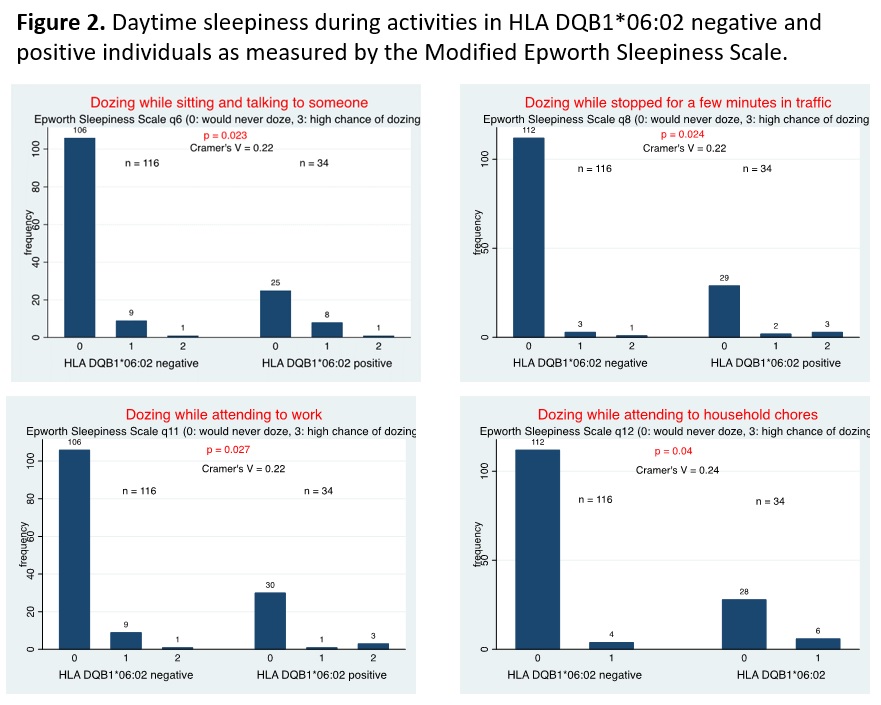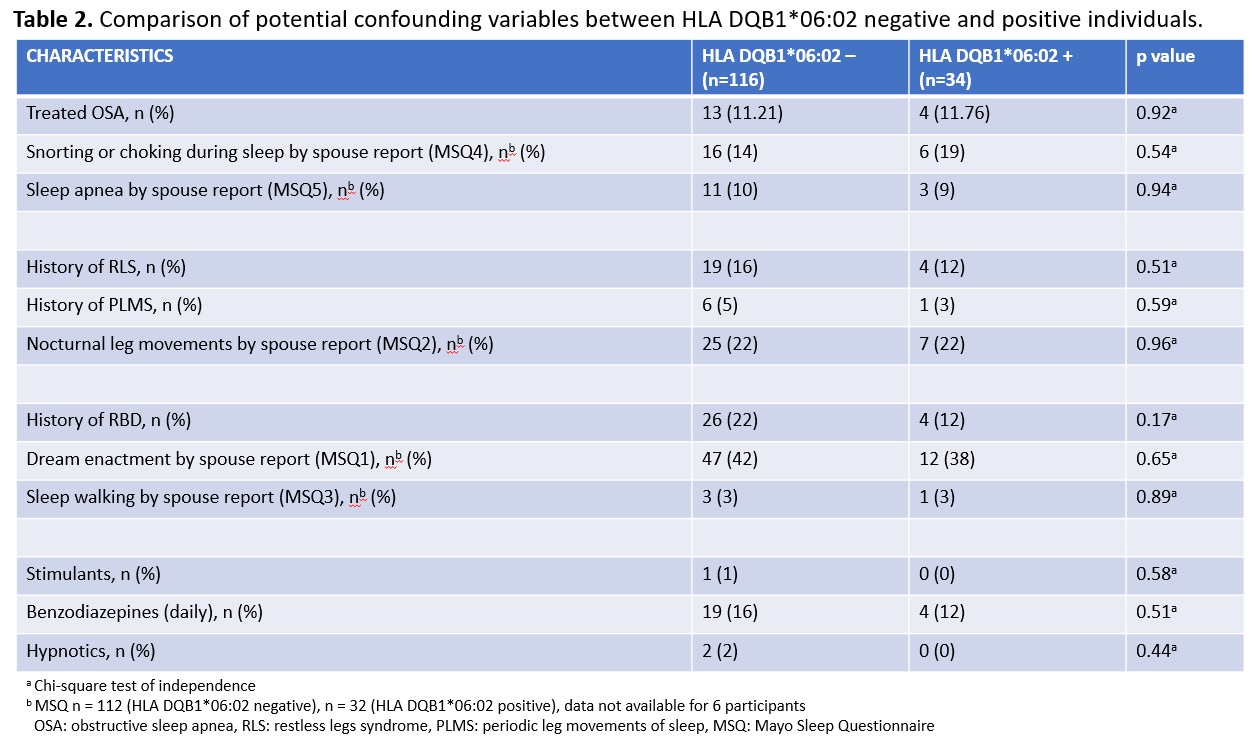Category: Parkinson's Disease: Non-Motor Symptoms
Objective: To determine whether narcolepsy risk allele HLA DQB1*0602 is associated with excessive daytime sleepiness (EDS) in patients with Parkinson’s disease (PD) on dopaminergic agents.
Background: Excessive daytime sleepiness is a common and disabling non-motor manifestation of Parkinson’s disease[1]. EDS mechanisms are poorly understood and no markers exist. Hypothalamic neurodegeneration has been associated with other non-motor manifestations in PD. HLA DQB1*0602 is a genetic marker present in 98% of individuals with narcolepsy type I[2]. Asymptomatic HLA DQB1*0602 carriers (12-30% of the general population) may become symptomatic under certain environmental conditions[3,4]. We hypothesize that HLA DQB1*0602 is associated with an increased risk of EDS in individuals with PD on dopaminergic agents.
Method: Prospective observational study of 150 PD individuals on dopaminergic agents. Main outcome measures were HLA DQB1*0602 status and the Modified Epworth Sleepiness Scale (mESS)[5]. Individuals with Montreal Cognitive Assessment score less than 24, Schwab and England Activities of Daily Living Scale under 70, a history of narcolepsy, hypersomnia, untreated sleep apnea, significant medical or psychiatric comorbidities, dementia, deep brain stimulation and shift workers were excluded. Confounding variables for EDS were assessed using Parkinson’s Disease Sleep Scale version 2 (PDSS-2), Mayo Sleep Questionnaire, Unified Parkinson Disease Rating Scale, Hoehn and Yahr scale. Variables were tested for normality (Shapiro-Wilk test), followed by Mann-Whitney U test (not normally distributed), t tests (normally distributed), and Chi-square tests (categorical).
Results: Participant demographics were statistically similar in the HLA DQB1*0602 negative and positive groups [Table1]. The HLA DQB1*0602 positive group demonstrated significantly more EDS than the HLA DQB1*0602 negative group, while the two groups were comparable in levodopa equivalent dosage [Figure1]. EDS was more pronounced during activities [Figure2]. No between-group differences were found in confounding variables [Table2], including sleep measures on the PDSS-2.
Conclusion: HLA DQB1*0602 increases the risk of EDS in PD individuals on dopaminergic drugs, especially during activities. This may suggest increased vulnerability to hypothalamic neurodegeneration in this PD subpopulation.
References: [1]Gjerstad, M. D., G. Alves, T. Wentzel-Larsen, D. Aarsland and J. P. Larsen (2006). “Excessive daytime sleepiness in Parkinson disease: is it the drugs or the disease?” Neurology 67(5): 853-858 [2]Scammell, T. E. (2015). “Narcolepsy.” N Engl J Med 373(27): 2654-2662 [3]Goel, N., S. Banks, E. Mignot and D. F. Dinges (2010). “DQB1*06:02 predicts interindividual differences in physiologic sleep, sleepiness, and fatigue.” Neurology 75(17): 1509-1519. [4] Nohynek, H., J. Jokinen, M. Partinen, O. Vaarala, T. Kirjavainen, J. Sundman, S. L. Himanen, C. Hublin, I. Julkunen, P. Olsen, O. Saarenpaa-Heikkila and T. Kilpi (2012). “AS03 adjuvanted AH1N1 vaccine associated with an abrupt increase in the incidence of childhood narcolepsy in Finland.” PLoS One 7(3): e33536. [5] Hobson, D. E., A. E. Lang, W. R. Martin, A. Razmy, J. Rivest and J. Fleming (2002). “Excessive daytime sleepiness and sudden-onset sleep in Parkinson disease: a survey by the Canadian Movement Disorders Group.” JAMA 287(4): 455-463.
To cite this abstract in AMA style:
S. Azher, E. Molho, A. Hahn, O. Adam. Excessive Daytime Sleepiness in Parkinson’s disease and Narcolepsy Genetic Risk Allele HLA DQB1*0602 [abstract]. Mov Disord. 2020; 35 (suppl 1). https://www.mdsabstracts.org/abstract/excessive-daytime-sleepiness-in-parkinsons-disease-and-narcolepsy-genetic-risk-allele-hla-dqb10602/. Accessed December 27, 2025.« Back to MDS Virtual Congress 2020
MDS Abstracts - https://www.mdsabstracts.org/abstract/excessive-daytime-sleepiness-in-parkinsons-disease-and-narcolepsy-genetic-risk-allele-hla-dqb10602/




